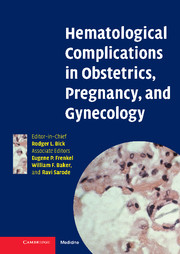Book contents
- Frontmatter
- Contents
- List of contributors
- Preface
- 1 Disseminated intravascular coagulation in obstetrics, pregnancy, and gynecology: Criteria for diagnosis and management
- 2 Recurrent miscarriage syndrome and infertility caused by blood coagulation protein/platelet defects
- 3 Von Willebrand disease and other bleeding disorders in obstetrics
- 4 Hemolytic disease of the fetus and newborn caused by ABO, Rhesus, and other blood group alloantibodies
- 5 Hereditary and acquired thrombophilia in pregnancy
- 6 Thromboprophylaxis and treatment of thrombosis in pregnancy
- 7 Diagnosis of deep vein thrombosis and pulmonary embolism in pregnancy
- 8 Hemorrhagic and thrombotic lesions of the placenta
- 9 Iron deficiency, folate, and vitamin B12 deficiency in pregnancy, obstetrics, and gynecology
- 10 Thrombosis prophylaxis and risk factors for thrombosis in gynecologic oncology
- 11 Low molecular weight heparins in pregnancy
- 12 Post partum hemorrhage: Prevention, diagnosis, and management
- 13 Hemoglobinopathies in pregnancy
- 14 Genetic counseling and prenatal diagnosis
- 15 Thrombocytopenia in pregnancy
- 16 Neonatal immune thrombocytopenias
- 17 The rational use of blood and its components in obstetrical and gynecological bleeding complications
- 18 Heparin-induced thrombocytopenia in pregnancy
- 19 Coagulation defects as a cause for menstrual disorders
- Index
- Plate section
- References
1 - Disseminated intravascular coagulation in obstetrics, pregnancy, and gynecology: Criteria for diagnosis and management
Published online by Cambridge University Press: 01 February 2010
- Frontmatter
- Contents
- List of contributors
- Preface
- 1 Disseminated intravascular coagulation in obstetrics, pregnancy, and gynecology: Criteria for diagnosis and management
- 2 Recurrent miscarriage syndrome and infertility caused by blood coagulation protein/platelet defects
- 3 Von Willebrand disease and other bleeding disorders in obstetrics
- 4 Hemolytic disease of the fetus and newborn caused by ABO, Rhesus, and other blood group alloantibodies
- 5 Hereditary and acquired thrombophilia in pregnancy
- 6 Thromboprophylaxis and treatment of thrombosis in pregnancy
- 7 Diagnosis of deep vein thrombosis and pulmonary embolism in pregnancy
- 8 Hemorrhagic and thrombotic lesions of the placenta
- 9 Iron deficiency, folate, and vitamin B12 deficiency in pregnancy, obstetrics, and gynecology
- 10 Thrombosis prophylaxis and risk factors for thrombosis in gynecologic oncology
- 11 Low molecular weight heparins in pregnancy
- 12 Post partum hemorrhage: Prevention, diagnosis, and management
- 13 Hemoglobinopathies in pregnancy
- 14 Genetic counseling and prenatal diagnosis
- 15 Thrombocytopenia in pregnancy
- 16 Neonatal immune thrombocytopenias
- 17 The rational use of blood and its components in obstetrical and gynecological bleeding complications
- 18 Heparin-induced thrombocytopenia in pregnancy
- 19 Coagulation defects as a cause for menstrual disorders
- Index
- Plate section
- References
Summary
Syndromes of disseminated intravascular coagulation in obstetrics, pregnancy and gynecology Objective criteria for diagnosis and management
Introduction
Disseminated intravascular coagulation is a confusing syndrome, regarding diagnostic and therapeutic modalities. Confusion and controversy stem from (1) the fact that many unrelated clinical scenario may induce DIC (2) a lack of uniformity in clinical manifestations (3) confusion regarding appropriate laboratory diagnosis and (4) unclear guidelines for management with respect to specific therapeutic modalities potentially available. Recommendations for and evaluation of management becomes even more difficult because: (1) the morbidity and survival is often dependent on the specific cause of DIC and (2) few of the generally used specific modes of therapy, heparin, antithrombin concentrate, protein C concentrate, and others, have been subjected to objective prospective randomized trials, except antithrombin concentrates.
This chapter provides specific and objective guidelines and criteria for (1) the clinical diagnosis, (2) laboratory diagnosis, and (3) to provide objective systems to assess efficacy of any given specific therapeutic modality, independent of influences of the underlying (inducing) disease causing the DIC in obstetrical, pregnancy or gynecological patients. This approach allows for objective decisions regarding diagnosis and management in particular obstetric and gynecological settings and in individual patients. A general review of the etiology, pathophysiology, clinical and laboratory diagnosis, and management modalities suggested for DIC in obstetrics and gynecology is provided.
Disseminated intravascular coagulation (DIC) is an intermediary mechanism of disease usually seen in association with well-defined clinical disorders.
- Type
- Chapter
- Information
- Publisher: Cambridge University PressPrint publication year: 2006



